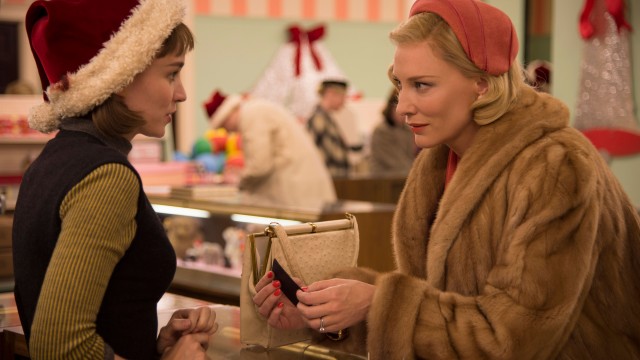Todd Haynes is a director who proves that style can be substance. He is also not one to show much restraint. Safe is among the most horrific non-horror films I’ve ever seen, and his Bob Dylan biopic I’m Not There needed multiple actors playing the lead character in order to contain its ideas. Carol is the closest that Todd Haynes has come to making a film that can be considered subdued, and with that in mind he ties that feeling to every aspect of this story.
In adapting the Patricia Highsmith novel The Price of Salt, Todd Haynes applies both a familiar embrace of genre evoking style, but with a unique perspective. The pastel colours he employs are utterly gorgeous, calling to mind the same Technicolour dramas from the fifties period the movie is taking place (making this a sort of companion piece to the Sirksiean Far From Heaven). But it is shot on grainier film stock by cinematographer Edward Lachmann, and they in turn shoot the lead characters through cars and windows as though they were the lonely inhabitants of Edward Hopper paintings. The result is a movie with beauty and colour underneath, over a colder surface that means the emotions are always bursting to come out.
The inhabitants of Hayne’s paintings are Therese (Rooney Mara) and Carol (Cate Blanchett), both actresses playing their roles beautifully, and with similar restraints to the film they are in. Therese – in career best work by Mara, who should be nominated for best LEAD actress at the Oscars – is inhibited by both a shyness and lack of experience in her emotions, to the point that she starts almost oblivious to the idea of lesbianism. Carol is moderated by societal values and the ire of her (not yet) divorced husband (played with humility by Kyle Chandler even amongst the pathetic). They are as much dolls to other people as the toys in the department store that Therese works in (which, incidentally, is the most artfully filmed toy store/sexuality metaphor since Eyes Wide Shut).
As a result this a movie whose main emotions are conveyed through hands. The first shown moment of affection is the touch of shoulders, the camera lingers on the movements of fingers, and the instigator of the movie is a leather pair of gloves.
In many ways this is a quintessential Christmas movie, in that the Christmas setting of the movie is so integral to the film. The world is inhabited by eye-popping reds, green and yellows, and any semblance of coldness of the movie is only in the same way as the thawing snow. This is a subversive love story, so subversive that the main colour of love is not the obvious passion of red, but of blue*. And even if the ultimate moment of release is not allowed to be given the over-boiling passion that it was going for (probably due to one actor’s non-nudity clause), and some sub-plots add drama that could be considered unnecessary given the central passion of the story, the ultimate payoff of Carol is the perfect encapsulation of the film’s high emotion but sustained philosophy.
Carol is among the best films I’ve seen this year, with the most rich of direction, an equally lush score by the always excellent Carter Burwell, and amazing performances from its two leads as they allow all their emotional walls to melt away.
*I thought this even before I could make any tenuous Blue is the Warmest Colour references, so I’ll just say the sex scenes in this movie are of a definite contrast to the one’s there.

